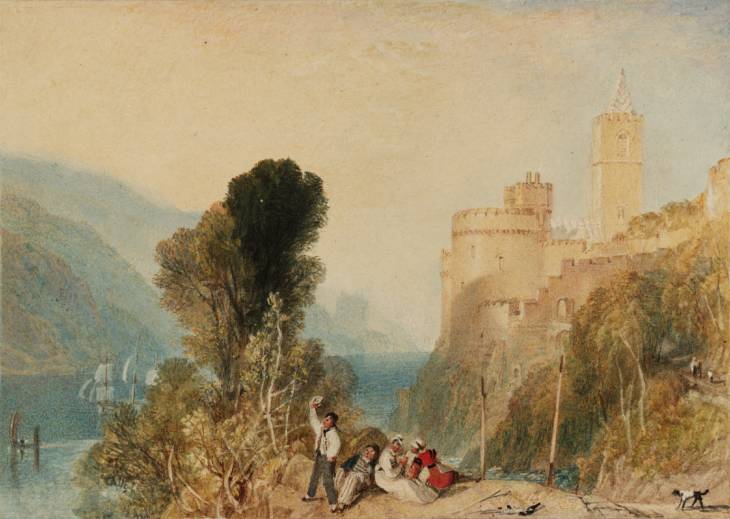Joseph Mallord William Turner Dartmouth Castle, on the River Dart 1822
Joseph Mallord William Turner,
Dartmouth Castle, on the River Dart
1822
Joseph Mallord William Turner 1775–1851
Dartmouth Castle, on the River Dart 1822
D18137
Turner Bequest CCVIII D
Turner Bequest CCVIII D
Pencil and watercolour on white wove watercolour paper, 158 x 223 mm
Blind-stamped with Turner Bequest monogram towards bottom right
Blind-stamped with Turner Bequest monogram towards bottom right
Accepted by the nation as part of the Turner Bequest 1856
Exhibition history
1904
National Gallery, London, various dates to at least 1904 (164).
1936
[Display of Watercolours], National Gallery, London, November 1936–September 1939 (no catalogue).
1951
An Exhibition of Paintings by J.M.W. Turner (1775–1851) to Commemorate the Centennial of his Death, Art Gallery of Toronto and National Gallery of Canada, Ottawa, October–December 1951 (50).
1980
Turner at the Bankside Gallery: Drawings & Water-colours of British River Scenes from the British Museum, Bankside Gallery, London, November–December 1980 (57).
1983
Turner and the Human Figure: Watercolours from the Turner Bequest, Loaned by the British Museum, Tate Gallery, London, December 1983–July 1984 (no catalogue).
1993
J.M.W. Turner 1775–1851: Impressions de Gran Bretanya i el Continent Europeu / Impresiones de Gran Bretaña y el Continente Europeo, Centre Cultural de la Fundació ”la Caixa”, Barcelona, September–November 1993, Sala de Exposiciones de la Fundación ”la Caixa”, Madrid, November 1993–January 1994 (34, reproduced in colour).
1994
J.M.W. Turner 1775–1851: Aquarelles et Dessins du Legs Turner: Collection de la Tate Gallery, Londres/Watercolours and Drawings from the Turner Bequest: Collection from the Tate Gallery, London, Palais des Beaux-Arts de Charleroi, September–December 1994 (34, reproduced in colour).
2003
Turner’s Britain, Gas Hall, Birmingham Museums & Art Gallery, November 2003–February 2004 (83, reproduced in colour; pl.99).
References
1904
E.T. Cook and Alexander Wedderburn (eds.), Library Edition: The Works of John Ruskin: Volume XIII: Turner: The Harbours of England; Catalogues and Notes, London 1904, p.615, no.164, as ‘The Dart. Dartmouth Castle’.
1909
A.J. Finberg, A Complete Inventory of the Drawings of the Turner Bequest, London 1909, vol.II, p.629, CCVIII D, as ‘Dartmouth Castle’.
1990
Eric Shanes, Turner’s England 1810–38, London 1990, p.107, no.82 (colour).
1996
Julius Bryant, Turner: Painting the Nation: English Heritage Properties as Seen by J.M.W. Turner, London 1996, p.52, reproduced p.53 (colour).
In contrast to Dartmouth, on the River Dart (Tate D18136; Turner Bequest CCVIII C), the focus of this view is the environs around Dartmouth Castle, a fortification which has guarded the mouth of the Dart estuary in Devon since the end of the fifteenth century. According to the art historian Julius Bryant ‘the prosperous merchants of the town further upstream invested in its erection as a defence against retaliation from local and foreign competitors’.1 Dating from 1494, the castle is situated a mile south of Dartmouth, a town with ‘a natural, deep water anchorage’ and which served as ‘one of the largest ports in England’ when construction on the castle began.2 The fortification was enlarged and rearmed in the eighteenth and nineteenth centuries as part of British artillery lines. The limestone tower of the Church of St Petrox can be seen immediately behind the castle. In the distance, protruding into the estuary on a rocky promontory, is the neighbouring Kingswear Castle.
Sailors can be seen carousing in the foreground, in front of an area of brambled foliage and trees. One shipmate waves enthusiastically towards the river probably in a gesture of camaraderie to fellow sailors; the other is slumped comically on a boulder wearing a rather stupefied expression, likely the result of a night of overindulgence (see the empty bottle next to the swords to the right). Their female companions look less than impressed.
In transit on the placid Dart is a small sailboat navigated by a solitary mariner, and a ship with bright white sails. The rendering of the foliage, trees, and hillside at the left bank displays a complexity and richness of tone and texture achieved through Turner’s stippling technique and meticulous layering of pigment.
For other sketches of Dartmouth Castle, see Turner’s Devonshire Coast, No.1 sketchbook (D08786; Turner Bequest CXXIII 237a), which bears some resemblance to the composition in this finished watercolour. In the same sketchbook see: Tate D08365, D08366, D08527, D08783, D08785; Turner Bequest CXXIII 2a, 3, 84, 235a, 237. See also Turner’s Devon Rivers, No.2 sketchbook (Tate D09737; Turner Bequest CXXXIII55). Both the Castle and the tower of the Church of St Petrox appear distantly in the backgrounds of two other watercolour drawings: Dartmouth Cove, with Sailor’s Wedding (private collection) from the England and Wales series of about 1825 and Dartmouth, Devonshire (whereabouts unknown) from the Southern Coast series of about 1811.
This drawing was engraved in mezzotint by Thomas Lupton and published in 1824 (Tate impressions T04802–T04804) and again by Samuel William Reynolds in 1835 (Tate impression T04808).
Verso:
Stamped in black with Turner Bequest monogram and ‘CCVIII D’ at centre; inscribed in pencil ‘D’ at centre, ‘?25’ towards top centre, and ‘D’ towards top left.
Alice Rylance-Watson
March 2013
How to cite
Alice Rylance-Watson, ‘Dartmouth Castle, on the River Dart 1822 by Joseph Mallord William Turner’, catalogue entry, March 2013, in David Blayney Brown (ed.), J.M.W. Turner: Sketchbooks, Drawings and Watercolours, Tate Research Publication, August 2014, https://www

